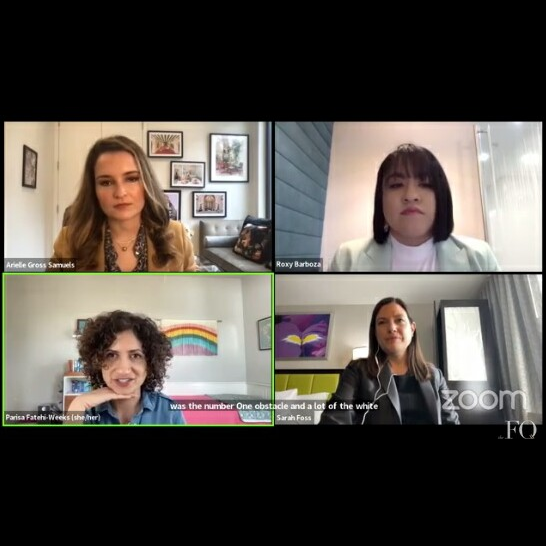Industry Leaders on Bridging the Digital Divide

Having the latest technology in our homes, workplaces and palms of our hands has become a near-absolute necessity as technology becomes increasingly embedded into our day-to-day lives, in and out of the workplace. But there is an ever-widening economic gap that keeps entire communities at a distinct digital disadvantage. During SXSW the Female Quotient's Equality Lounge assembled a panel of industry leaders and experts for an intriguing and insightful discussion about how companies can tackle the digital divide between low-income and marginalized communities and increase their access to essential technology.
Arielle Gross Samuels, Global Head, Environmental, Social, Governance Marketing, Meta, moderated the discussion, and kicked things off asking the panel what they felt were the biggest obstacles that are preventing people from accessing technology. Roxanna Barboza, Industry and Cybersecurity Policy Analyst, NTCA -- The Rural Broadband Association, shared that the lack of updated and accurate data was a contributing factor. "FCC Broadband maps are based on data collected by the government and not granular enough to accurately identify underserved areas," she said. "Here at NTCA, we are constantly advocating for more granular mapping, standards for reporting and competitive overlap challenge processes."
"There needs to be a real commitment ensuring that everything is connected in a seamless way," added Sarah Foss, Chief Technology Officer, Audacy. "We've seen certain devices are deemed as essential services, or schools are able to give [out some devices]. We've seen manufacturers do that, but the infrastructure, training and literacy are all trailing where the physical devices are present."
"Across the landscape, whether it's an urban or rural environment, how do we ensure that the infrastructure really has the connectivity that can also increase their capabilities through some of that literacy and training that is part of a total package?" Foss asked. "We're seeing things come in bits and pieces with manufacturers or certain governments trying to fund this. The pandemic really accelerated all of it, but now we're left with a patchwork quilt. Certain places have the devices, certain places with infrastructure, but we've really got to connect these dots, especially the companies that can make the content available."
When asked if there were tools and strategies that have been employed that could be scaled to improve accessibility, Foss replied, "I think there are, but the question is, 'Are we moving fast enough to actually do it?'" She then expressed how radio, television and cable have provided greater access and bandwidth, and are "expanding the pipes" to deliver the services that are needed: entertainment, information and education.
The panel agreed that the technological disparities among marginalized communities became very apparent when the COVID-19 pandemic struck the United States, forcing schools to shut down and resources for remote learning were stretched thin.
"In our white papers, digital literacy was often cited as the No. 1 barrier to people having internet in the home or having access to broadband," Parisa Fatehi-Weeks, Senior Director, Global Community Impact, Indeed, said. "While it's certainly true and a lot of folks need some assistance in just navigating the space, I think it's become much more clear that affordability is a huge issue and frankly, No. 1 in urban areas where there are options but it might not be cost-effective to sign up."
"Companies have a role in partnering and supporting and lifting up those efforts and not getting in the way of them," she continued. "It's so essential, it's so utility-like. To leave it to chance and leave it to the market to solve, of course it's going to be a patchwork with holes in it. Companies are smart in trying to develop some case studies but also advocate the rising tide that lifts all."
Fatehi-Weeks went on to highlight the National Digital Inclusion Alliance, which continues to grow their Digital Navigator Corps, a group of trusted guides who are from and live within communities and act as "digital social workers," helping people to connect to the internet to live their lives and "get the things they need to thrive day-to-day. Companies have a big role in supporting things like that."
Barboza spoke about the need for community assessments to determine what the true needs are in different areas. "We can have all of these ideas and want to provide digital literacy courses when they really just want to learn how to use WhatsApp because that's what they need and how they get online," she explained. "We have to cater our ideas to theirs to better serve the community. If we're not listening and understanding their needs, then what's the point of what we're doing?"
The final topic of the panel concerned the rapid arrival of Web3 and the metaverse, with Samuels asking the group what the future may hold with building a more inclusive and diverse environment. Foss replied that Audacy looks forward to the "new playground. It's a new way of how content is going to be leveraged and engaged across different communities.
"We're looking at Web3 as a place where we need to do more education," she continued. "For as much as good as it may be able to do, there's a lot of places where it could go off the deep end. As it explodes, other companies are going to have to make that same type of commitment. It's going to be moving so fast, that if we don't have those guardrails, we could end up having technology become even more divisive instead of building a bridge across the divide."
That's a warning that should most definitely be heeded as this technological expansion continues.
In closing, Samuels asked the three panelists if they had any calls to action for the executives and key company players in attendance. Barboza shared four: "Keep an eye on federal and state funding for broadband, have your organization engage with and establish relationships with your local community service providers, communicate with your family members the benefits of being connected, and always be willing to bring a folding chair with you. What I mean by that is to be willing to be a mentor for future leaders. We won't always be here."
Foss closed out the panel by imploring companies to take the time to listen to what their users, consumers and listeners want and need from their platforms. "For the digital divide, helping elevate voices that need to be heard, that will then engage with us just beyond the device and the infrastructure, policy handles that," she said. "But policy doesn't hit content. That's an obligation we have as publishers and tech companies."
Click the social buttons to share this content with your friends and colleagues.
The opinions and points of view expressed in this content are exclusively the views of the author and/or subject(s) and do not necessarily represent the views of MediaVillage.com/MyersBizNet, Inc. management or associated writers.


